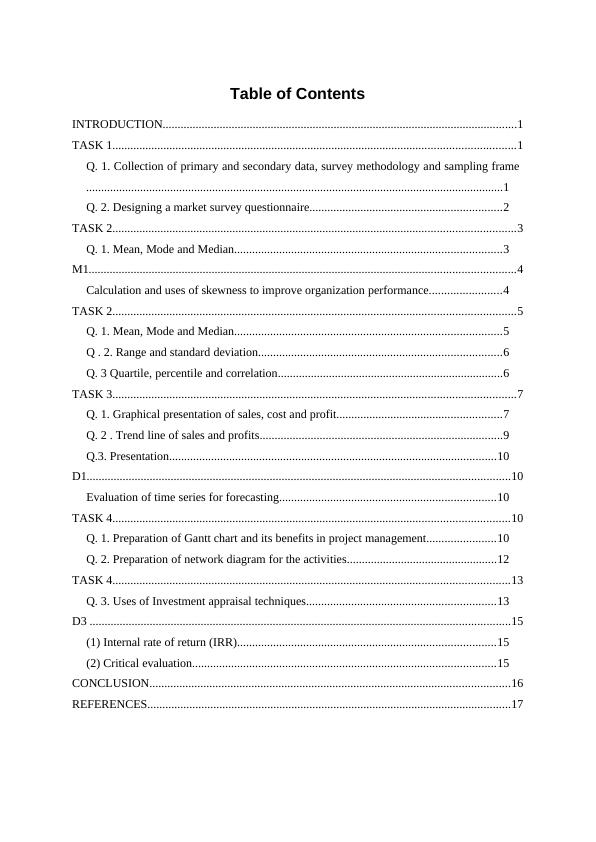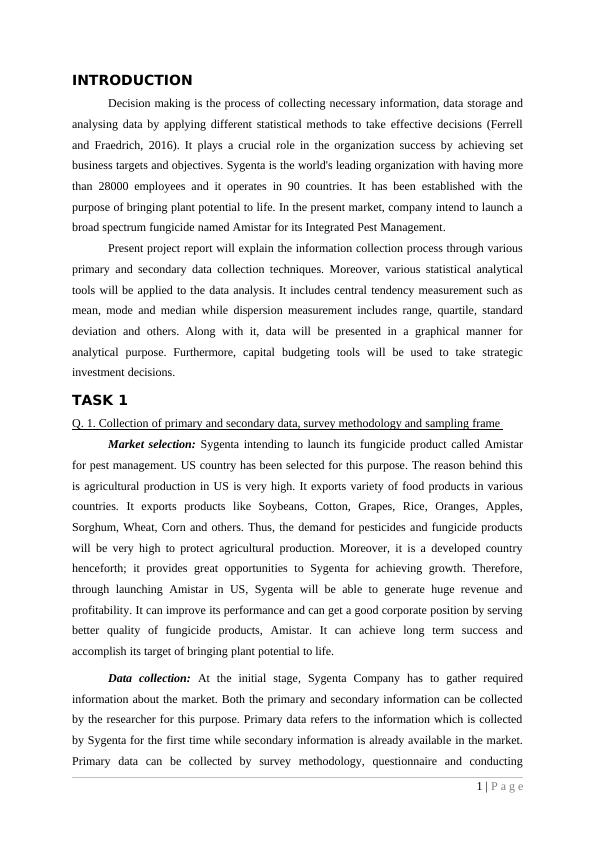Process of Business Decision Making
Added on 2020-01-23
20 Pages5243 Words143 Views
BUSINESS DECISION MAKING

Table of ContentsINTRODUCTION......................................................................................................................1TASK 1......................................................................................................................................1Q. 1. Collection of primary and secondary data, survey methodology and sampling frame ...........................................................................................................................................1Q. 2. Designing a market survey questionnaire................................................................2TASK 2......................................................................................................................................3Q. 1. Mean, Mode and Median.........................................................................................3M1..............................................................................................................................................4Calculation and uses of skewness to improve organization performance........................4TASK 2......................................................................................................................................5Q. 1. Mean, Mode and Median.........................................................................................5Q . 2. Range and standard deviation.................................................................................6Q. 3 Quartile, percentile and correlation...........................................................................6TASK 3......................................................................................................................................7Q. 1. Graphical presentation of sales, cost and profit.......................................................7Q. 2 . Trend line of sales and profits.................................................................................9Q.3. Presentation.............................................................................................................10D1.............................................................................................................................................10Evaluation of time series for forecasting........................................................................10TASK 4....................................................................................................................................10Q. 1. Preparation of Gantt chart and its benefits in project management.......................10Q. 2. Preparation of network diagram for the activities..................................................12TASK 4....................................................................................................................................13Q. 3. Uses of Investment appraisal techniques...............................................................13D3 ............................................................................................................................................15(1) Internal rate of return (IRR)......................................................................................15(2) Critical evaluation.....................................................................................................15CONCLUSION........................................................................................................................16REFERENCES.........................................................................................................................17

INTRODUCTIONDecision making is the process of collecting necessary information, data storage andanalysing data by applying different statistical methods to take effective decisions (Ferrelland Fraedrich, 2016). It plays a crucial role in the organization success by achieving setbusiness targets and objectives. Sygenta is the world's leading organization with having morethan 28000 employees and it operates in 90 countries. It has been established with thepurpose of bringing plant potential to life. In the present market, company intend to launch abroad spectrum fungicide named Amistar for its Integrated Pest Management. Present project report will explain the information collection process through variousprimary and secondary data collection techniques. Moreover, various statistical analyticaltools will be applied to the data analysis. It includes central tendency measurement such asmean, mode and median while dispersion measurement includes range, quartile, standarddeviation and others. Along with it, data will be presented in a graphical manner foranalytical purpose. Furthermore, capital budgeting tools will be used to take strategicinvestment decisions. TASK 1Q. 1. Collection of primary and secondary data, survey methodology and sampling frame Market selection: Sygenta intending to launch its fungicide product called Amistarfor pest management. US country has been selected for this purpose. The reason behind thisis agricultural production in US is very high. It exports variety of food products in variouscountries. It exports products like Soybeans, Cotton, Grapes, Rice, Oranges, Apples,Sorghum, Wheat, Corn and others. Thus, the demand for pesticides and fungicide productswill be very high to protect agricultural production. Moreover, it is a developed countryhenceforth; it provides great opportunities to Sygenta for achieving growth. Therefore,through launching Amistar in US, Sygenta will be able to generate huge revenue andprofitability. It can improve its performance and can get a good corporate position by servingbetter quality of fungicide products, Amistar. It can achieve long term success andaccomplish its target of bringing plant potential to life. Data collection: At the initial stage, Sygenta Company has to gather requiredinformation about the market. Both the primary and secondary information can be collectedby the researcher for this purpose. Primary data refers to the information which is collectedby Sygenta for the first time while secondary information is already available in the market.Primary data can be collected by survey methodology, questionnaire and conducting1 | P a g e

interviews. It provides assistance to Sygenta for collecting large quantity of data andappropriate for gathering specific information about Amistar. On contrary, secondary datacan be gathered through historical industrial sales records, their published annual reports, USgovernment economic reports, trade reports, internet, published scholarly articles, books,newspaper, magazines and reports published by trade associations. It takes less time andeffort in data collection process. Survey methodology and Sampling frame: Conducting survey is the best way ofgathering specific information about the market. In context to Sygenta, researcher canconstruct questionnaire for this purpose. Under this method, researcher can design varioustypes of questions and collect information. They can determine consumer demand, theirsatisfaction, purchasing power and their buying behaviour to determine the opportunities forfuture growth (Clemen and Reilly, 2013). Moreover, web questionnaire can be used toprovide assistance to gather information from a wider geographical place. Another methodfor data collection is sampling frame. It is not possible for Sygenta to gather informationabout overall population. Thus, sampling frame can be used in this case. It is a method inwhich Sygenta's investigator has to select appropriate size of sample by including all thecharacteristics of universe and collecting information from them. Random sampling methodcan be used for this purpose in which all the members have an equal chance of inclusion insample. The success of this method is dependent upon the appropriateness of the sample. Q. 2. Designing a market survey questionnaireName:Age:Gender:1. Do you make use of Sygenta's offered products and services?YesNo2. Do you think that Sygenta's products have improved your agricultural production?YesNo 3. Which are the most important factors that affect your pricing decisions?Cost effective Prices Standard QualityOffered discount rates2 | P a g e

End of preview
Want to access all the pages? Upload your documents or become a member.
Related Documents
BUSINESS DECISION MAKING TABLE OF CONTENTS INTROUCTION 3 TASK 13lg...
|21
|4914
|433
Business Decision Making in Syngenta- Reportlg...
|17
|3479
|48
Business Decision Making (BDM) - PDFlg...
|18
|4610
|187
Business Decision Making in Syngenta : Reportlg...
|27
|7363
|87
Business Development Management Case of Syngenta - Reportlg...
|21
|4867
|83
Business Decision Making INTRODUCTIONlg...
|20
|3946
|94
